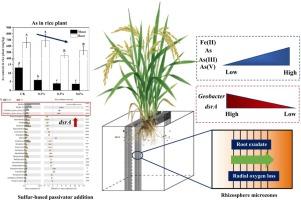硫基钝化剂处理水稻根际微区砷转化及功能微生物的空间变异
IF 11.3
1区 环境科学与生态学
Q1 ENGINEERING, ENVIRONMENTAL
引用次数: 0
摘要
水稻对砷(As)的吸收严重依赖于砷的形成,而砷的形成受根际微区根介导的生物地球化学过程的动态调节。然而,固定化条件下砷转化和相关微生物功能性状的空间异质性尚不清楚。利用根箱系统,我们揭示了硫基钝化剂应用后水稻根际微区As生物利用度和功能微生物群落的毫米级梯度。钝化剂的加入显著降低了土壤孔隙水中砷、亚砷酸盐(As(III))和砷酸盐(As(V))总量和水稻植株内砷的积累。添加钝化剂后,硫酸盐还原基因(dsrA)丰度增加了136 ~ 225%,功能微生物(如梭状芽孢杆菌和芽孢杆菌)也增加了。根际微区砷的空间分布表现出强烈的距离依赖迁移模式。从根近端(0 ~ 2 mm)到远端(8 ~ 10 mm),总砷、总砷(III)和总砷(V)含量分别增加了36 ~ 83%、36 ~ 110%和28 ~ 397%。添加钝化剂后,Geobacter和dsrA基因丰度在根近端区(0 ~ 2mm)达到峰值,促进了砷的固存。这些发现表明,硫基钝化剂通过硫-铁相互作用放大根际效应,建立了以硫酸盐-铁还原为主的砷固定途径。根际砷形成和功能基因的异质性揭示了根际介导砷固定化的机制,促进了原位砷修复策略的发展。本文章由计算机程序翻译,如有差异,请以英文原文为准。

Spatial variation of arsenic transformation and functional microorganisms across the rice rhizosphere microzone with sulfur-based passivator
Arsenic (As) uptake by rice is critically dependent on As speciation, which is dynamically regulated by root-mediated biogeochemical processes in the rhizosphere microzones. However, the spatial heterogeneity of As transformation and associated microbial functional traits under immobilization amendments remains poorly understood. Using a rhizobox system, we revealed millimeter-scale gradients in As bioavailability and functional microbial communities across rice rhizosphere microzones following sulfur-based passivator application. Passivator addition significantly reduced total As, arsenite (As(III)) and arsenate (As(V)) in soil porewater and As accumulation in rice plants. The abundances of sulfate-reducing gene (dsrA) increased by 136-225% and the functional microorganisms (e.g., Clostridium and Bacillus) were also increased with passivator amendment. The spatial distribution of As across the rhizosphere microzones exhibited strong distance-dependent mobility patterns. Total As, As(III) and As(V) increased from root-proximal (0-2 mm) to far-rhizosphere (8-10 mm) zones by 36-83%, 36-110%, and 28-397%, respectively. The abundances Geobacter and dsrA gene peaked in the root-proximal zone (0-2 mm) with passivator addition, driving As sequestration. These findings highlight that sulfur-based passivator amplifies rhizosphere effects through sulfur-iron interactions, establishing a sulfate-iron reduction-dominated As immobilization pathway. Rhizosphere heterogeneity in As speciation and functional genes revealed mechanisms of rhizosphere-mediated As immobilization, advancing in situ As remediation strategies.
求助全文
通过发布文献求助,成功后即可免费获取论文全文。
去求助
来源期刊

Journal of Hazardous Materials
工程技术-工程:环境
CiteScore
25.40
自引率
5.90%
发文量
3059
审稿时长
58 days
期刊介绍:
The Journal of Hazardous Materials serves as a global platform for promoting cutting-edge research in the field of Environmental Science and Engineering. Our publication features a wide range of articles, including full-length research papers, review articles, and perspectives, with the aim of enhancing our understanding of the dangers and risks associated with various materials concerning public health and the environment. It is important to note that the term "environmental contaminants" refers specifically to substances that pose hazardous effects through contamination, while excluding those that do not have such impacts on the environment or human health. Moreover, we emphasize the distinction between wastes and hazardous materials in order to provide further clarity on the scope of the journal. We have a keen interest in exploring specific compounds and microbial agents that have adverse effects on the environment.
 求助内容:
求助内容: 应助结果提醒方式:
应助结果提醒方式:


